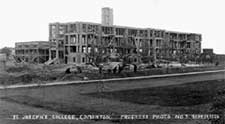| |
 |
| |
Click on image for larger version. |
There was not much to be seen south and west of the site of St. Joseph's College when the cornerstone was laid on September 22, 1926. Construction on the new Catholic college at the University of Alberta had been underway on the southern edge of campus since the sod turning the previous May, and now a platform was set in place for the assembled dignitaries:
Archbishop O'Leary, Henry Marshall Tory, Premier Rutherford, and representatives of the Christian Brothers, the religious order which had undertaken the direction of the College. Behind them stretched autumn fields, as on that fine September day the cornerstone was set in place for the new building and the new institution. Both were to flourish.
Henry Marshall Tory, himself an ordained minister of the Methodist Church, insisted from the foundation of the University of Alberta that it be a non-denominational institution. But included in his vision of the University were denominational colleges, and largely through his influence provision was made for colleges of the various religious denominations. Protestant St. Stephen's was on the scene (and the campus) even before the actual founding of the University. St. Joseph's, the Roman Catholic College, became an actuality in 1926 by an act of the Legislature of Alberta on April 8 of that year, and by an "Agreement of Affiliation" with the University of Alberta three weeks later.
The founding of a Catholic college affiliated with the University had been high on the list of priorities of Archbishop Legal, who headed the Archdiocese of Edmonton from 1912 to 1920. It was his successor, Archbishop Joseph O'Leary who realized the idea, though not without considerable difficulty and several disappointments. The latter came mostly from trying to get a religious order to undertake the work. In 1925 the Christian Brothers from Toronto consented to direct the College. They also undertook to find the money.
The Carnegie Foundation in New York had offered the sum of $100,000 for an affiliated Catholic College if the grant could be matched. Brother Alfred of the Christian Brothers set about raising the necessary money in Alberta, visiting small towns and parishes in the middle and southern parts of the province. He succeeded, and the list of donations from persons and places with small purses and large hearts is a tribute to the generosity and convictions of the people of the young Province.
St. Joseph's College as it stands today, in the very heart of the campus, is three things: a teaching component of the University of Alberta, a residence for men students enrolled in any and all the University's faculties, and the centre of the Catholic Campus Ministry. In the beginning it was chiefly as a residence for Catholic students that it was known, although the Christian Brothers taught in the University system from the beginning. As a residence, the College naturally became one of the centres of social activities for the entire campus. St. Joe's had its own gym (now a library), and in-house sports generated men and means for University-wide athletic activity. The cafeteria was a campus centre before, between and after lectures for coffee and conversation. St. Joe's was the best place for dances, a regular place of worship, and the handiest place for highjinks. Of these last, there is many a memory, as some who read these lines will surely testify.
Still a residence, and still a strong centre of spiritual and social activity, St. Joe's has become a much more prominent teaching component of the University. At present, the College offers some 26 courses in Christian theology and 13 in philosophy. In a full academic year, about 1,500 students take courses at the College, and these courses are for credit in the various faculties of the University. St. Joseph's teaching staff comprises 18 persons, 13 of whom teach full-time.
This Jubilee Year marks an important and happy moment in the life of St. Joseph's College. The sixtieth anniversary of its foundation will be celebrated in several ways. On September 23, the unique and strikingly beautiful stained glass windows in the Chapel will be blessed and presented. In the course of the academic year, 1986-87, there will be a jubilee lecture series at the University and, subsequently, a jubilee Volume published. The College's alumni will hold their annual dinner at the Faculty Club on November 7, an event of great success in recent years, to be celebrated with special eclat in this anniversary year. And it is hoped that the visit of the Governor General, which was to have been held on May 1 but was postponed, will take place at some time in the course of the year.
The Canadian system of affiliated colleges, which has enriched our universities for more than a century, is seen in one of its happiest and most harmonious examples in St. Joseph's. While the College benefits immeasurably by being part of a great university, the University, on its part, is the richer and more complete for the presence of an institution like St. Joe's, where teaching, the meeting of minds, friendship, conversation, spiritual guidance, worship, and all those things which are good and true in university life are fostered. Ad multos et faustissimos annos!
Published Autumn 1986. |